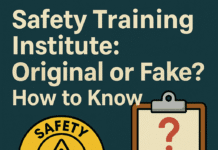
Introduction to SAMTRAC: Understanding the Importance of Safety Training
In today’s fast-paced, high-risk working environments, safety is a top priority. Whether in construction, manufacturing, or the oil and gas sector, ensuring employees’ health and safety is not just a legal requirement but a moral one. This is where SAMTRAC, a renowned safety training course, comes into play. SAMTRAC is more than just a course; it’s a game-changer in workplace safety management.
What is SAMTRAC?
SAMTRAC, short for Safety Management Training Course, is a globally recognized qualification in Health, Safety, and Environmental (HSE) management. Designed for safety officers, managers, and supervisors, this course equips professionals with the knowledge and tools needed to manage workplace risks effectively.
The Origins of SAMTRAC
The SAMTRAC course was developed by NOSA (National Occupational Safety Association) in South Africa. Since its inception, it has evolved to meet international standards, making it a go-to certification for safety professionals worldwide.
Importance of Safety Training in Today’s World
Why is safety training so important today? As industries become more complex, workplace hazards increase, making it essential for companies to prioritize safety. Proper training ensures that employees can identify risks and manage them before they result in accidents or injuries.
The Key Components of SAMTRAC
SAMTRAC isn’t just a generic safety course. It delves deep into specific areas crucial for maintaining a safe and compliant work environment.
Health, Safety, and Environmental Management Systems
SAMTRAC places a significant focus on HSE management systems. These systems allow organizations to create a structured approach to managing safety, health, and environmental concerns, ensuring compliance with regulations and standards.
Risk Management and Hazard Identification
One of the key components of SAMTRAC is its emphasis on risk management. Learners are taught how to identify hazards, assess risks, and implement controls to reduce the likelihood of accidents.
Legislative Knowledge and Compliance
Understanding laws and regulations is essential for any safety professional. SAMTRAC covers the legal side of safety management, ensuring that professionals are up to date with relevant legislation in their industry.
Why SAMTRAC is Essential for Safety Officers
Enhancing Safety Knowledge and Skills
For safety officers, continuous learning is critical. SAMTRAC provides updated knowledge and practical skills, making safety officers more effective in their roles.
Increasing Employability in the Safety Sector
With more companies seeking qualified safety professionals, a SAMTRAC certification can significantly boost your employability, opening doors to more job opportunities.
How SAMTRAC Contributes to Workplace Safety
Proactive vs. Reactive Safety Management
A major benefit of SAMTRAC is its focus on proactive safety management. Instead of waiting for accidents to happen, SAMTRAC-trained professionals can anticipate risks and implement preventive measures.
Reducing Workplace Incidents and Accidents
SAMTRAC-trained employees contribute to a reduction in workplace incidents by identifying hazards early and addressing them before they lead to harm.
Building a Safety Culture
One of the key takeaways from SAMTRAC is the importance of fostering a safety culture. Employees at all levels become safety-conscious, creating a safer work environment for everyone.
The Benefits of SAMTRAC Certification
Industry Recognition and Credibility
SAMTRAC is widely recognized in various industries, from construction to oil and gas, making it a credible qualification for safety professionals.
Career Growth and Advancement Opportunities
Earning a SAMTRAC certification can fast-track your career. Many safety professionals have seen significant career growth and higher-paying opportunities after completing the course.
Versatility Across Different Sectors
One of the best things about SAMTRAC is its versatility. It’s not limited to one industry, making it a valuable asset whether you work in construction, mining, or manufacturing.
Who Should Enroll in SAMTRAC Training?
Safety Officers and HSE Professionals
If you’re a safety officer or an HSE professional, SAMTRAC will enhance your skills and knowledge, helping you manage workplace safety more effectively.
Supervisors and Managers
Supervisors and managers can also benefit from SAMTRAC training, as it provides them with the tools to oversee safety practices within their teams.
Employees Seeking Safety Knowledge
Even if you’re not in a dedicated safety role, SAMTRAC can provide valuable insights into safety management, making you a more well-rounded employee.
The SAMTRAC Course Structure
Introduction to Health and Safety Principles
The course starts with an introduction to health and safety principles, providing a foundation for understanding workplace safety.
Advanced Risk Assessment Techniques
As you progress, SAMTRAC dives into advanced risk assessment techniques, ensuring you can identify and mitigate risks effectively.
Practical Applications in Safety Management
SAMTRAC emphasizes practical applications, helping learners implement what they’ve learned in real-world scenarios.
SAMTRAC’s Global Reach
International Recognition
SAMTRAC’s global recognition makes it a sought-after qualification for safety professionals worldwide, from South Africa to the Middle East and beyond.
Adapting to Local Safety Regulations
While SAMTRAC follows international standards, it’s also adaptable to local safety regulations, making it relevant in various region
Online vs. In-Person SAMTRAC Training
Flexibility of Online Learning
SAMTRAC offers flexible online options, allowing learners to complete the course at their own pace and convenience.
Hands-On Benefits of In-Person Courses
For those who prefer hands-on learning, in-person courses provide practical experience and real-time interactions with trainers.
How to Get Started with SAMTRAC
Prerequisites for Enrollment
Before enrolling, it’s essential to check the prerequisites, which usually include basic health and safety knowledge.
Where to Find Accredited SAMTRAC Providers
There are several accredited SAMTRAC providers worldwide. A quick search online will help you find one that suits your location and learning style.
Introduction to SAMTRAC: Understanding the Importance of Safety Training
In today’s world, where workplace safety is a top priority across industries, SAMTRAC (Safety Management Training Course) has become a vital certification for professionals in the health, safety, and environment (HSE) field. This globally recognized training program equips individuals with the necessary skills to identify, assess, and mitigate risks in various work environments, particularly high-risk sectors like construction, oil and gas, and manufacturing. As businesses strive to maintain compliance with safety regulations and reduce workplace accidents, SAMTRAC training plays an essential role in preparing safety officers and managers to meet these challenges.
What is SAMTRAC?
SAMTRAC is a comprehensive training program developed by NOSA (National Occupational Safety Association) that focuses on occupational health and safety management. It is designed to provide both theoretical knowledge and practical applications, enabling safety professionals to effectively manage risks and ensure compliance with legal and regulatory requirements. SAMTRAC covers a wide range of topics, from hazard identification and risk assessment to incident investigation and environmental management, making it a well-rounded course for those entering or advancing in the safety field.
The Importance of Safety Training
Safety training, like SAMTRAC, is crucial for several reasons:
- Minimizing Workplace Hazards: One of the primary objectives of safety training is to equip employees with the knowledge and skills to identify potential hazards and take proactive measures to prevent accidents. SAMTRAC focuses on risk assessment, empowering safety officers to implement strategies that minimize workplace hazards.
- Legal Compliance: Every organization must comply with local and international safety regulations. SAMTRAC training ensures that professionals understand the legal framework surrounding workplace safety, helping companies avoid penalties and legal consequences due to non-compliance.
- Improving Safety Culture: A strong safety culture is integral to reducing accidents and injuries. SAMTRAC promotes a proactive approach to safety, encouraging employees to prioritize safety in their daily operations, which ultimately leads to a safer working environment.
- Reducing Costs: Workplace accidents can result in significant financial losses for companies, including medical costs, legal fees, and lost productivity. SAMTRAC-trained professionals help to lower these costs by preventing accidents and ensuring that safety protocols are followed.
Who Should Take SAMTRAC?
SAMTRAC is ideal for a wide range of professionals, including:
- Safety Officers: Responsible for implementing safety protocols and ensuring workplace compliance.
- HSE Managers: Oversee safety programs and ensure that all departments are adhering to safety regulations.
- Supervisors and Managers: Involved in high-risk industries such as construction, oil and gas, or manufacturing.
- Aspiring Safety Professionals: Individuals looking to start a career in occupational health and safety.
Conclusion: Why SAMTRAC is a Game-Changer for Safety Professionals
In conclusion, SAMTRAC is not just a certification but a comprehensive approach to safety management that can enhance your career and make workplaces safer. Whether you’re a safety officer, a manager, or just looking to boost your safety knowledge, SAMTRAC offers valuable insights and practical skills.
Types of Safety Career and Its Scope
National Association of Safety Professionals (NASP)
Associate Safety Professional (ASP) Certificate Course
Certified Safety Professional (CSP) Certificate Course
Occupational Safety and Health Administration (OSHA) Training
FAQs
What is the duration of the SAMTRAC course?
The SAMTRAC course typically lasts between 5 to 10 days, depending on the mode of study.
Is SAMTRAC recognized internationally?
Yes, SAMTRAC is globally recognized and is highly valued across various industries.
How much does SAMTRAC certification cost?
The cost of SAMTRAC certification varies by provider, but it generally ranges from $500 to $1,200.
Can I do SAMTRAC training online?
Yes, SAMTRAC offers both online and in-person training options, making it accessible to learners globally.
What industries benefit most from SAMTRAC training?
Industries such as construction, oil and gas, manufacturing, and mining benefit significantly from SAMTRAC-trained professionals.
























